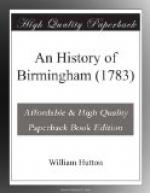A son not only succeeds his father in the possession of his property and habitation, but also in the grave, where he can scarcely enter without expelling half a dozen of his ancestors.
The antiquity of St. Martin’s will appear by surveying the adjacent ground. From the eminence upon which the High-street stands, proceeds a steep, and regular descent into Moor-street, Digbeth, down Spiceal-street, Lee’s-lane, and Worcester-street. This descent is broken only by the church-yard; which, through a long course of internment, for ages, is augmented into a considerable hill, chiefly composed of the refuse of life. We may, therefore, safely remark, in this place, the dead are raised up. Nor shall we be surprised at the rapid growth of the hill, when we consider this little point of land was alone that hungry grave which devoured the whole inhabitants, during the long ages of existence, till the year 1715, when St. Philip’s was opened. The curious observer will easily discover, the fabric has lost that symmetry which should ever attend architecture, by the growth of the soil about it, causing a low appearance in the building, so that instead of the church burying the dead, the dead would, in time, have buried the church.
It is reasonable to allow, the original approach into this place was by a flight of steps, not by descent, as is the present case; and that the church-yard was surrounded by a low wall. As the ground swelled by the accumulation of the dead, wall after wall was added to support the growing soil; thus the fence and the hill sprang up together; but this was demonstrated, August 27, 1781, when, in removing two or three old houses, to widen St. Martin’s Lane, they took down the church-yard wall, which was fifteen feet high without, and three within. This proved to be only an outward case, that covered another wall twelve feet high; in the front of which was a stone, elevated eight feet, and inscribed, “Robert Dallaway, Francis Burton.” Church-wardens, anno dom. (supposed) “1310.” As there is certain evidence, that the church is, much older then the above date, we should suspect there had been another fence many ages prior to this. But it was put beyond a doubt, when the workmen came to a third wall, four feet high, covered with antique coping, probably erected with the fabric itself, which would lead us far back into the Saxon times.
The removal of the buildings to accommodate the street, the construction of the wall, beautified with pallisades, is half an elegant plan, well executed. If we can persuade ourselves to perform the other half, by removing the remainder of the buildings, and continuing the line to the steps, at the bottom of Spiceal-street, the work will stand in the front of modern improvement.
In the south-east part of the wall, covered by the engine-house, upon another stone, nearly obliterated, is, John Enser, Richard Higginson, Church-wardens, 1709.




